So you want to… offer fishing?
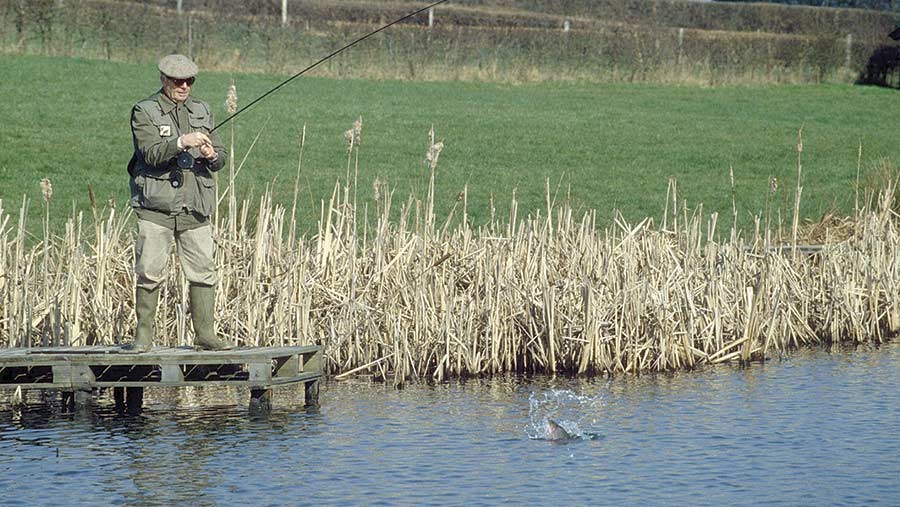 © John Curtis/Shutterstock
© John Curtis/Shutterstock For some farmers, diversifying into fishing seems like an obvious step. The market, by all accounts, is buoyant; many farms already have rivers, streams and lakes, so surely sticking in a few fish and charging people to take them out again is a no-brainer.
Of course, there is much more to it than that and farmers would be well advised to seek professional advice before taking the plunge.
To help navigate what can be tricky waters, Farmers Weekly talked to consultant David Pardoe from Strutt and Parker’s Salisbury office.
See also: So you want to… open a campsite?
What is the market like and does fishing make a good diversification?
There are two distinct types of fishing and two distinct markets. Fly fishing for trout is a more mature market, with a distinctly older clientele – the average fly fisherman or woman tends to be well into their middle age.
Also, the requirements for a trout fishery are more exacting – water quality, flow and temperature are critical, so the opportunities are fewer and further between to start a new venture.
The coarse fishing market is a bit different. Demand is higher, establishment and running costs are lower, and there is not the same requirement to restock, as the fish once caught are put back.
The market is definitely growing too, and is more age diverse. It’s a relatively cheap day out – especially compared with fly fishing – and more people are holidaying at home rather than abroad, looking for something to do.
What’s the best business model?
That depends on what level of involvement you want. For many, simply letting out a lake or river to a club or syndicate secures some income for minimal involvement.
But others prefer to be more hands-on, employing a fishery manager and getting more involved in managing the business. It’s a personal choice.
What are the key skills needed to make a go of it?
Being in the fishing business is akin to being in the entertainment business. You need to have excellent people skills – especially for fly fishing, but also for coarse fishing.
You also need to be good at marketing and savvy at social media – or at least employ the services of someone who is.
To some extent, the market will develop by word of mouth and reputation is everything, but you do need to appeal to people on Facebook and Instagram too.
The chances are, you will also need to bring in expertise to manage the fishery. There are some very specific husbandry skills required and the risk of something going wrong with fish stock is high.
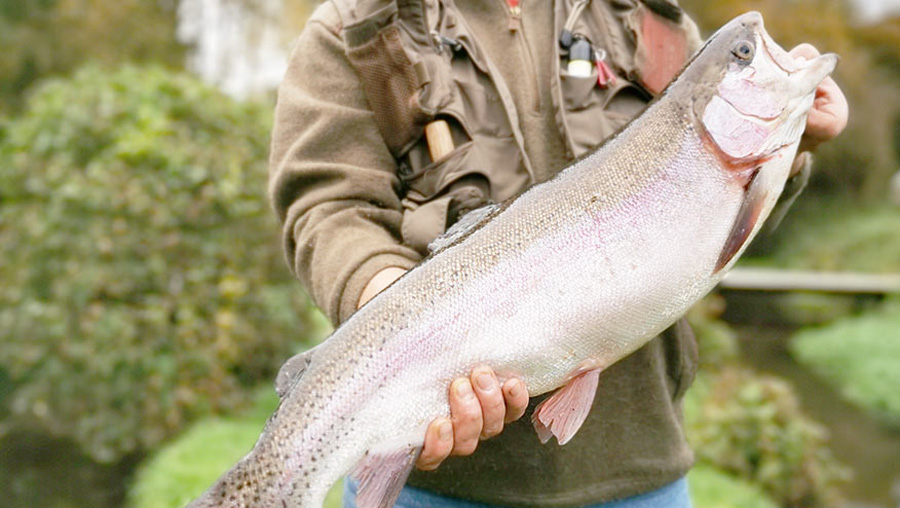
A rainbow trout at Manningford
Do I need planning permission?
Yes, even if you are just digging a hole in the ground to make a pond for coarse fishing, you may need a number of consents.
The Environment Agency will need to be involved to check you are not disturbing any protected species, such as bats or newts. And if you are putting up a lodge or other such facility, you will need planning permission.
And do I need a licence?
You will certainly need an abstraction licence – even if you are just diverting water from a river and returning it from the other end of the lake.
And if you are using a borehole or even a natural spring, you will need an abstraction licence.
You should always speak to the Environment Agency, to Defra and to the local authority before any diversification.
What about cash flow?
There is no doubt that fishing is seasonal. Different authorities have different rules in terms of a close season, though triploid trout can generally be fished for all year round in lakes, and coarse fisheries may or may not be subject to a close season.
Either way, there is no doubt that the key months are in summertime, so income is going to be subject to peaks and troughs.
How will any income be treated by the taxman?
That will depend on the business model. If the water is let to a club or syndicate, it will be treated like rent. But if the fishing is run by the farmer, it will be treated as a trading activity and taxed in the same way as the farm.
There can be complications around VAT. If you are selling day tickets, you are not selling fish, you are selling an experience.
This will be subject to VAT. But if you set up a syndicate or a sporting club to fish the water, you may be exempt from VAT.
Either way, it is important to take advice from your accountant so that you are clear about the tax position at the planning stage.
What insurance should I have?
You will definitely need public liability insurance to cover you against any accidents involving paying members of the public. Buildings insurance will also be needed for any physical structures relating to the diversification.
It is also advisable to insure your fish stock in case of disease, drought or flooding. This can be quite expensive, so talk to your broker. Some fishery owners take this cover, but quite a lot do not.
What are the main risks?
Disease is an obvious one, as are interruptions to water flows, changes to water quality and predators such as mink and herons.
Slurry spillages can play havoc with fisheries, as can agrochemicals if they inadvertently get into the water.
Crime is another consideration, although this may be less of an issue with fly fishing than coarse fishing. Specimen fish like big carp and catfish are worth an awful lot of money, so theft is a danger.
Another risk is possible bad publicity. A spate of negative media stories about fishing could drive people away. And then there is the weather…
Is it profitable?
That depends entirely on costs to establish, but many farmers find a fishing diversification can make a useful contribution to their incomes, but not much more than that.
Case study 1: Manningford Estate and Fishery, Pewsey, Wiltshire
Chris Nash has owned the Manningford estate for just over three years, having sold his original 565ha arable holding in Oxfordshire with the aim of downsizing the farming operation and diversifying his income base.
His new business included a slightly smaller farm – though it still amounts to 800ha of arable land to be worked once rented land is included – as well as some industrial units, cottages and an established but slightly tired trout farm and fishery.
“I sold most of the kit before we moved, so now we practice strip till, and farm all the land in hand,” he says.
“The fishery and fish farm needed a lot of work, but together with my fishery manager, Malcolm Hunt, we have really brought it up to spec, improving facilities and expanding the customer base.”
The fish farm now produces 30,000 brown and rainbow trout a year for external customers, and 10,000-18,000 fish for use at Manningford.
The home facilities, which are fed by the pristine waters of the Hampshire Avon, consist of the original 2ha Manor lake – excavated in 1982 – and the newer 0.5ha Squires lake, with fish ranging from 2lb to 20lb (0.9kg to 9kg).
“Attracting the right customers is key,” says Mr Nash. “We have invested time and effort in our branding, tying the fishery in with the rest of the estate.”
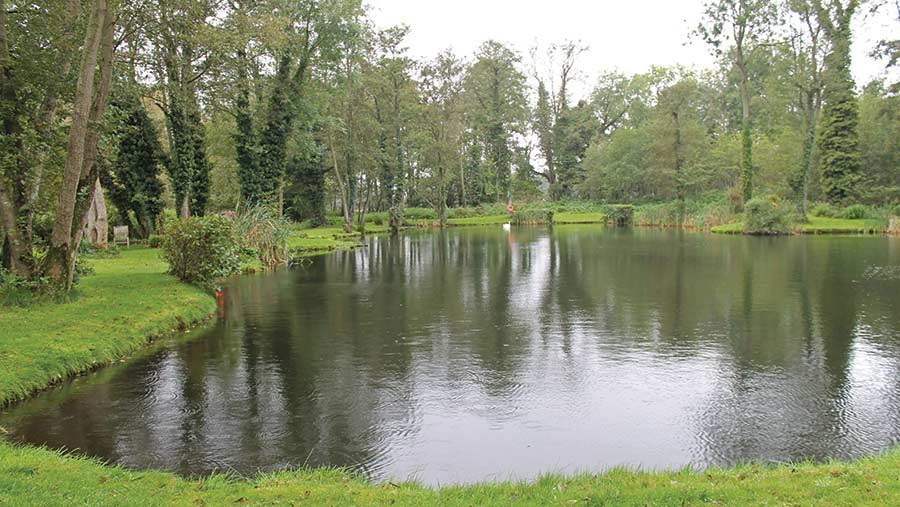
Squires Lake at Manningford
The aim has been to keep the site and the fishing as natural as possible, although since Mr Nash took over efforts have been made to open things up a bit, to make casting easier, while money has been invested in upgrading the fishing lodge, to provide a facility customers can relax in and enjoy.
Contribution
On the financial side, the view is that the trout fishery “makes a useful contribution”, but not a fortune.
With 3,400 paying customers a year, total revenue comes to about £156,000, with a further £36,000 from the fish farm.
This has to pay the wages of two full-time staff, plus the running of a dedicated vehicle and other maintenance kit.
“The fact we are able to get our fish stock at cost price from our own fish farm does help keep the thing viable,” says Mr Hunt. Income is also quite seasonal, with peaks in the spring and summer and troughs in the winter months.
“But the fact we are close to the source of the Avon does mean we have constant water temperatures, so we stay open every day of the year, except Christmas Day, Boxing Day and New Year’s Day.”
There are risks, of course. The quality of the offering is very dependent on water flow from the Avon, and that is strictly controlled by the Environment Agency.
“We only just have enough water flow on our licence,” says Mr Hunt. “And even though the water we take in at one end is returned to the river the other end, there is talk of the agency reducing our abstraction. If that happened, we would struggle.”
There are hidden costs too. For example, the main lake will soon need desilting and, even though this is something that needs doing only once every 15 or 20 years, it comes with a hefty £35,000 to £40,000 price tag.
People management
When it comes to the so-called “skill set” needed to run a fishery diversification, Mr Nash highlights attention to detail and people management.
“Fish are much like any other form of livestock – they have to be watched closely and signs of any problems need to be nipped in the bud,” he says.
“Malcolm has real expertise and knows his stuff, having studied fish farming at Plumpton Agricultural College and having worked for many years in the industry.”
As for interacting with customers, Mr Nash says its sometimes like being an agony aunt. “Coming here can be a bit of a social for many of our visitors, so we have to give them the time and attention they want, so hopefully they will come back again.”
Case study 2: More House Farm fishery, Wivelsfield
Mid-Sussex farmer Charlie Burgoyne is a man who likes a diversification.
As well as his home More House Farm at Wivelsfield, near Haywards Heath, and another 500-cow dairy unit he helps manage for the Kleinwort family, his business is built around a whole range of developments including commercial property lets, storage facilities, livery stables and a coarse fishery.
He says: “When I came back from college in 1989, we were still milking 350 dairy cows – a business my father had built up over many years. But we then started converting some of the older stone buildings, which we rented out.”
By 2007, it was clear that the commercial property side of things was making a better and far more stable income than the dairy, so the decision was taken to sell the cows and use the freed-up space for further developments.
Much of the pastureland on the 250ha farm was returned to arable production, although Mr Burgoyne does retain an 80-cow herd of Aberdeen Angus suckler cattle.
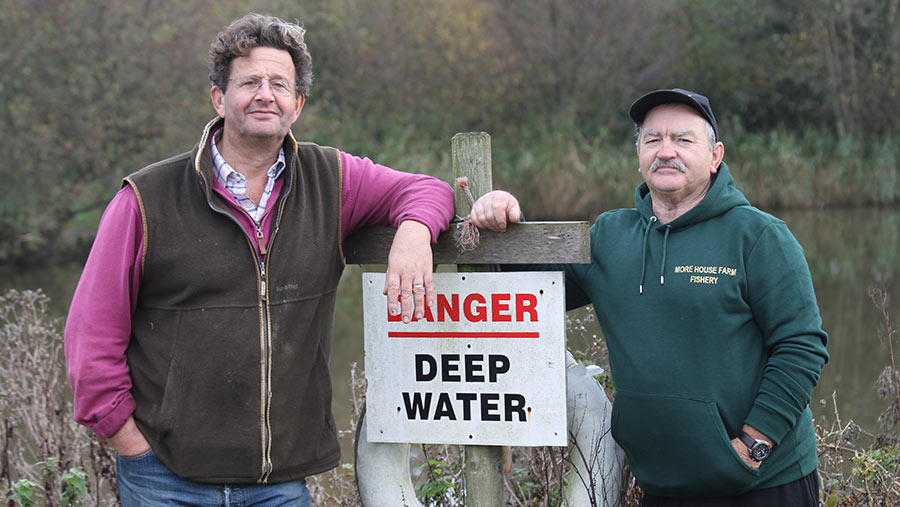
Charlie Burgoyne, left, and Rob Harman
And then there is the fishing.
“While we were developing the More House Farm site, a gentleman called Rob Harman turned up who I’d known before and who had been running a coarse fishery operation elsewhere. He said he was looking for a lake to start up a new venture.
“Well, we had a lake and a pond, and that’s how we got into it.”
The main lake, Kingfisher Lake, extends to 1.6ha and was built in 1980 as water storage for the former dairy herd.
“We had to clean it out using a drag line, but we now have a lake with 14 dedicated swims, with four to eight feet of water.”
Kingfisher, which is spring-fed, is the specimen lake, with carp to over 40lb and catfish of up to 60lb.
The other two lakes – the twisty Sidewinder and the 230m-long Canal – were both created by Mr Burgoyne and Mr Harman, dug out and built up using farm equipment and contractors.
“Much of this work was done on the basis of contra deals, so it did not cost a huge amount of money,” Mr Burgoyne says.
These two lakes are run as competition lakes, with local clubs and syndicates hiring them on a day basis for matches, with fishermen paying between £10 and £15 a head.
The initial investment cost came to about £30,000 for digging and dredging, and while Mr Burgoyne provides the lakes, tracks and infrastructure, Mr Harman is responsible for stocking the fish and the day-to-day running of the enterprise. Earnings are split down the middle.
“The income flow is seasonal,” says Mr Burgoyne. “Fishing is a year-round activity, but it definitely peaks in the summer months.”
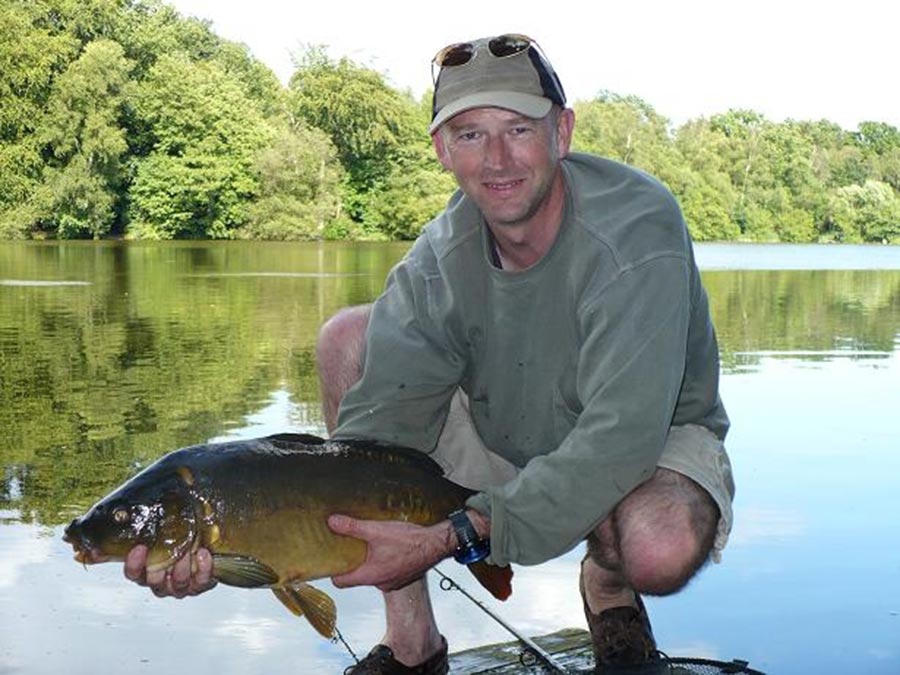
Demand for coarse fishing is still strong, he adds, with a burgeoning local population helping it grow. “But the emphasis is much more on the specimen side of things, while match angling seems to be declining – especially in this part of the country.”
Unlike trout fishing, there is not the same need to invest in upmarket facilities such as lodges and fancy toilets, although there is still an office where anglers pay their fees, while electric gates control access to the site.
“We don’t get much in the way of trouble from the anglers, though the night fishermen and their entourages can be a strange bunch,” says Mr Burgoyne.
“We do get some petty crime anyway, farming in such a built-up area, but the fishermen are pretty good.
“We do make them park a bit away from the water’s edge, mind you. Some of these specimen fish are worth a lot of money – a 40lb carp might fetch £20,000 on the black market – and we don’t want to see them disappearing.”
Overall, the fishing has been successful, providing a fairly low-input, low-output diversification which has made good use of an existing asset.
“We have also created the new lakes on land which was always too wet to be much good for farming,” says Mr Burgoyne.
“But in terms of the return that is possible for the area it takes up, it would not be worth sacrificing better agricultural land for it, in my opinion.”
Here to help…
Mr Burgoyne says he is happy to talk to other farmers who might be interested in fishing as a diversification.
He can be contacted on 07860 925 942 or email charlie@morehousefarm.demon.co.uk
